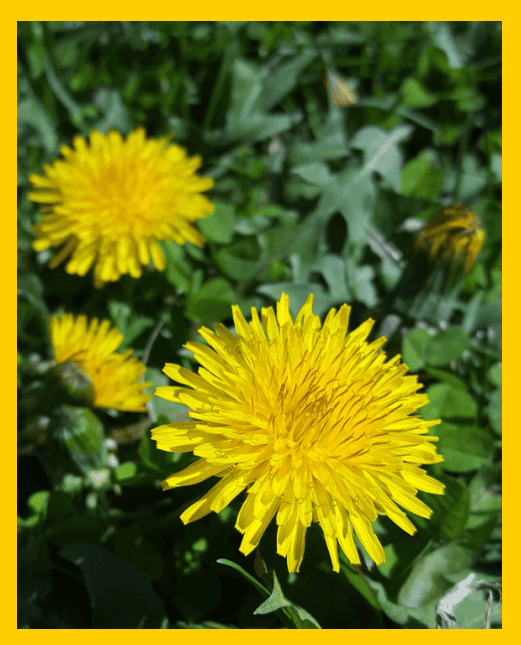April 4th is National Dandelion Day. What? A day for dandelions? Most gardeners are trying to get rid of dandelions from their yards, and especially their lawns. But there are many who not only see the benefit in them, but also celebrate them. It is true, I do enjoy seeing the bright discs of yellow popping in early spring when nothing else is blooming (or very few other things). While I do no go out of my way to encourage them in the lawn, I also do not poison them or rip them out. Sure, I will dig them out of the flower bed, but not the lawn.
For those of you who want to control dandelions in the lawn, see the end of this page where it says: Controlling Them in the Lawn. But I believe in sharing my space with things that are not necessarily harmful or invasive. I consider dandelions to be naturalized in North America. When did they arrive? What are their benefits? How can we gardeners coexist with them?
Where Did Dandelions Come From?
They are native to Europe and Asia and were originally thought to have come to North America on the Mayflower. In both Europe and Asia, dandelions were used as medicine to treat a variety of illnesses. I have read accounts where many settlers grew dandelions in their cottage and potager gardens both for food and medicine. All parts of the plant are edible, and useful. Because of their early arrival, they have long been naturalized and can be found throughout the United States and Canada.
Medicinal and Culinary Uses
As I mentioned above, dandelions can be eaten and used for medicinal purposes. One of the most common things to do with them is to use the fresh greens, either steamed or boiled, and eaten with or without bacon. I have read about this in many books, and it sounds delicious. Just like all greens, dandelions are rich in iron, vitamins A & C, and other nutrients. Tea can be made from all parts for various ailments. Even the Native Americans used dandelions for various maladies.

List of Common Uses of Dandelions
- The flower petals can be collected and steeped to make dandelion jelly (which is delicious).
- Roots can be boiled or steeped and eaten, or used to make tea for digestive ailments.
- The leaves can be eaten fresh or cooked.
- Some Native Americans made a tea from the roots for heartburn.
- The leaves can be used to stimulate the appetite and digestion.
- Dandelion flowers have antioxidant properties.
- A brew made from the roots can help with liver problems.
- Dandelion wine can be made from the flowers or the roots.
- In some cases, the roots have been roasted and ground as a coffee substitute.
Coexisting with Dandelions in the Landscape
Our first goal when it comes to dealing with dandelions should be to find ways to coexist with them. Not root them out or poison them and us. And besides the reasons above to grow them in the garden, there are other reasons to allow them to flourish within our landscapes.
Dandelions provide early season nectar for foraging bees. Of course, native plants are going to be better for native bees. But unfortunately, much of our native landscape and habitats have been altered or changed due to farming and the expansion of towns and roads. When you find native plant communities, relish them, treasure them. But be willing to work with what is available until you can either restore your corner of the earth to a more native state, or incorporate more native and naturalized plantings.
One of the most common bees seen on dandelions are honey bees, another invader from Europe and Asia. Honeybees have a hard time with many of our native plants because they were not meant to pollinate them. God created different things to work together, but in different ways. So if you have honeybees on the property, or are concerned about them, leaves some dandelion plants for them. And dandelions are here to stay, so why not let some grow, and provide for those early bees and other insects?

They also are great at moving nutrients through the soil. Many of our lawn grasses and other perennials have fibrous root systems which stay within the top 12 inches of soil. But things with taproots, such as comfrey, dandelion, and salsify, reach down deeper and pull nutrients which are unavailable to other plants, up to their leaves and then the soil surrounding.
Controlling Them in the Lawn
For those of you who have bought into the perfect lawn, weed free, this section is for you. I prefer to grow a lawn that is not only pleasing to see humming with insects, but also has beneficial “weeds” I can eat or use to help heal my family and I.
To control them in the lawn, treatment with a chemical (yuck) is best done in the fall or late summer, when they are sending stores of sugars down to the roots to last the winter. If you try this in the spring you will have mixed results. Other, less dangerous ways of controlling them include digging with a dandelion puller or small trowel. If you can get most of the taproot out, you will either weaken the plant for the next try, or kill it outright.

Conclusion
By allowing dandelion plants to thrive and flourish in your lawn, you can know that you are coexisting with a plant brought to America for its health benefits. And why not? Dandelions can be used for many things, and they provide food for bees and other wildlife as well. And did you know there are pink flowering dandelions? Maybe now I pipped your interest.
Happy planting!




